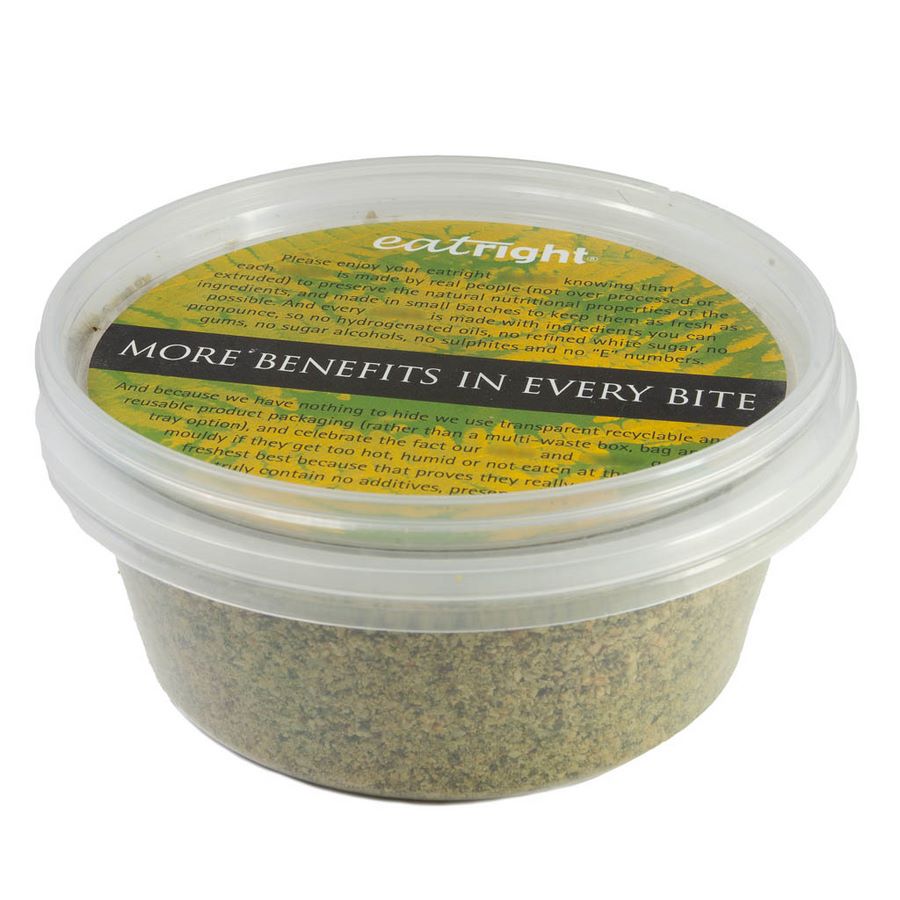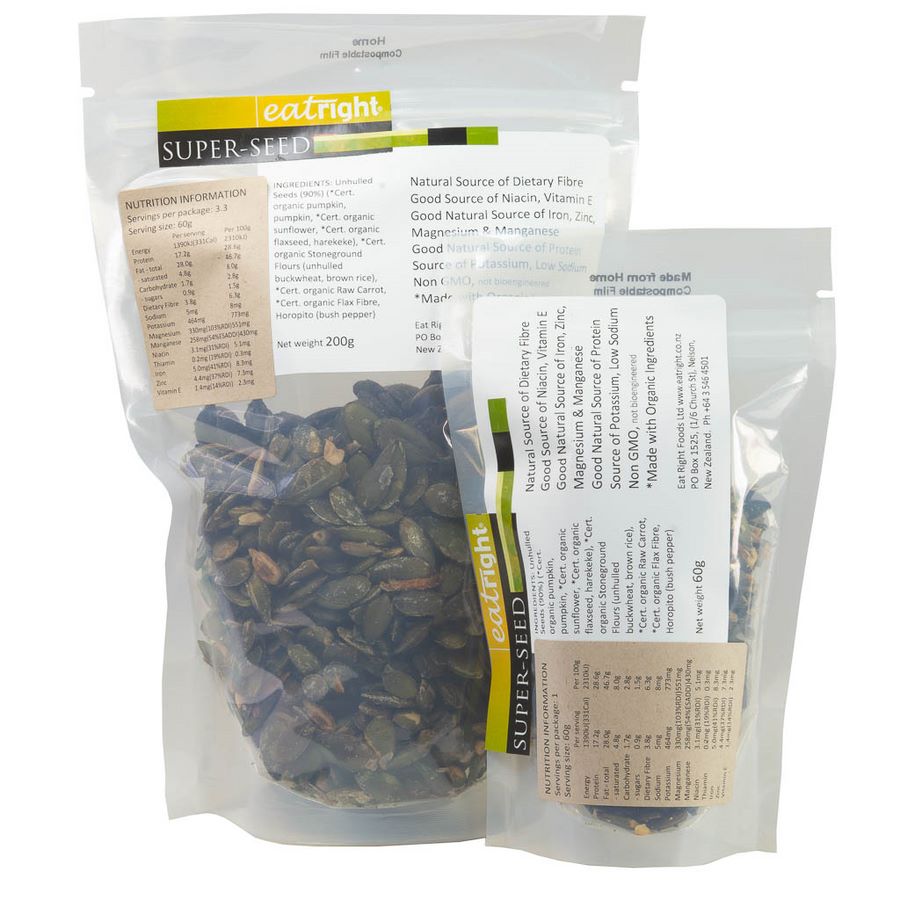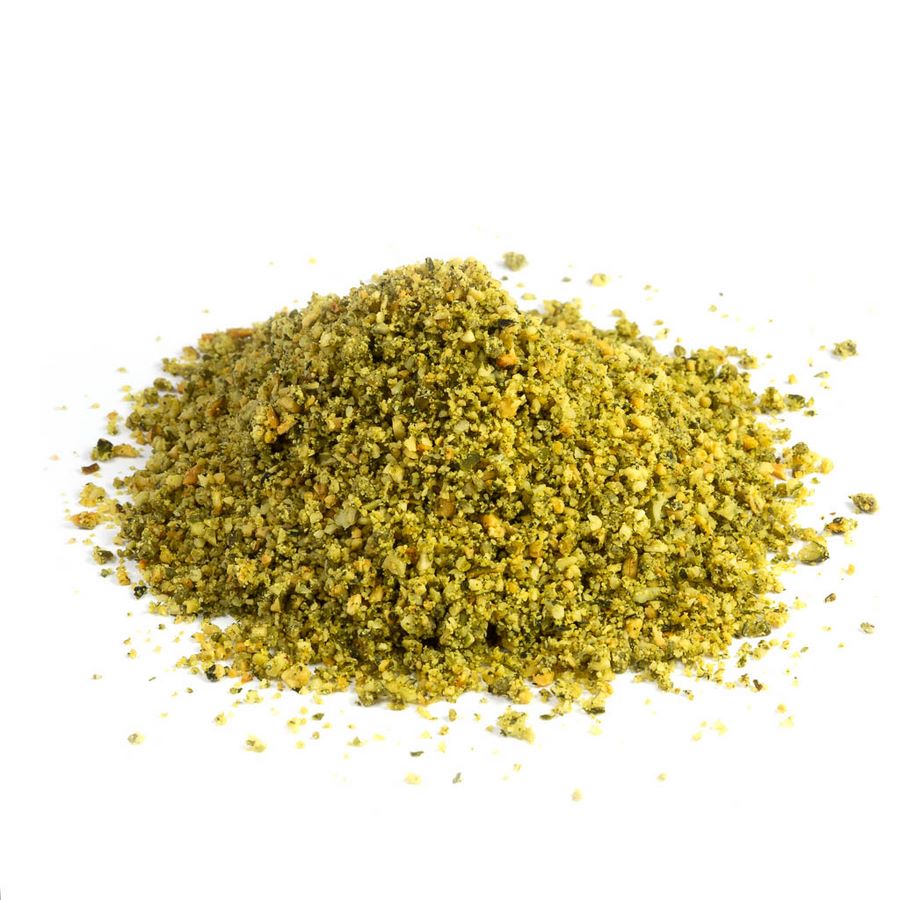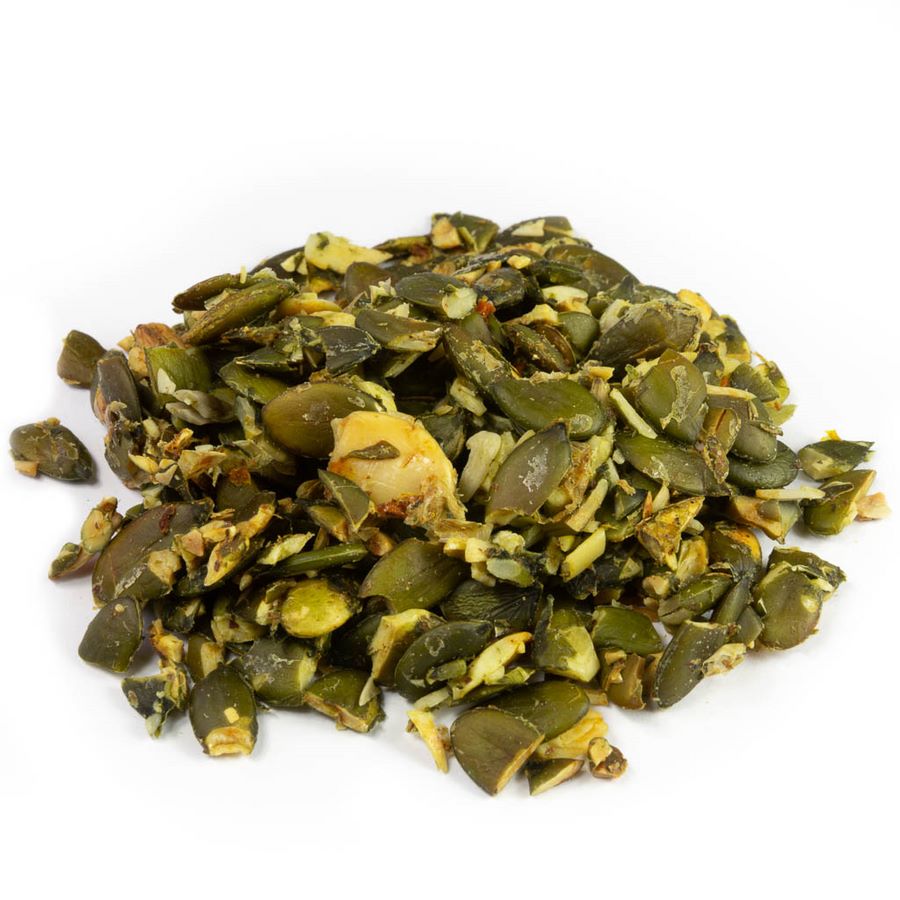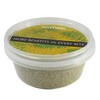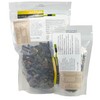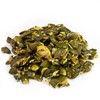EATRIGHT® Prescribed Super-SEEd Salutary CEREAL
Proudly presenting another 'not comparable' EATRIGHT® product with partially sprouted, part-germinated, mixed origin, in-house blend of unhulled organically grown (whenever possible) mixed seeds. A "no leftovers" ceREAL product with substantiation n. [L sto stand] nutritional claims.
The “pumpkin seeds have delta-7-sterols and selenium antiinflammatory activity” and "antiencephalopathic, essential" bioactive leucine [20,790-35,835ppm] (Duke, J. A. et al. '02, '16). The native New Zealand flax seeds (Harakeke, Phormium tenax, a traditional coffee substitute), therapeutic 'mountain product' bush pepper (Pepperwood, Pseudowintera colorata, natural antimicrobial source), carrots [UVB activated source of Diosgenin 6,000ppm, PubMedID: 21106928 and amphetaminagenic myristicin 68ppm] and a microdose of carrot family Pimpinella anisum (with anethole content 5407.9mg/100g; “official in N.F. (National Formulary) and F.C.C (Food Chemicals Codex)” and myristicin source). The mix is then lightly roasted (lower and slower in comparison to typical commercial methods) so the end product contributes to multiple health functions.
The curative [1] EATRIGHT® Super-SEEd (Salutary Cereal) is a seven, seed-to-shelf, product. It's an incremental yet robust, functional food product in a category of its own: a nutritious muesli, granola or breakfast cereal; a cold salad or hot soup topper; a great 'nosebag' or trail mix enjoyable at any-time. As an ingredient, the whole seeds taste great in bread and the freshly ground seeds (at dispatch) are a great alternative to bread dip seasonings, crumbs or crumble
Ingredients: Proprietary Unhulled Seed Medley (90%) (*cert. organic pumpkin (Cucurbita pepo) [2], open pollinate bred in New Zealand pumpkin (Cucurbita maxima), *cert. organic sunflower (Helianthus annuus L.), *cert. organic brown flaxseed (Linum usitatissimum L.) [3], flax seed (Phormium tenax), anise (Pimpinella anisum) [4], *cert. organic [sound & clean] non gluten stone ground grist (unhulled brank (a pseudo cereal (Fagopyrum esculentum Moench)), brown rice (Oryza sativa L.)), *cert, organic heritage raw carrot (Daucus carota L.) [lycopene content 80-140ppm] [5], *cert organic flaxfibre [6], higher altitude horopito (Pseudowintera colorata)
Nutrition Information per 60g (2.1oz) serving
NUTRITION: Energy 1390kJ (331Cal), Protein (17.2g), Fat-total (28.0g), Fat-sat (4.8g), Fat-trans (0g), Fat-poly (12.1g), Fat-mono (9.3g), CHO-total (1.7g), CHO-sugars (0.9g)(1%DV), Dietary Fiber (5.4g), Sodium (5mg), Iron (5.0mg)(59%RDA), Potassium (464mg)(39%RDA), Calcium (172mg/100g)(22%RDA)
Nutrition: [descending order of predominance by weight (mg)] Essential Amino Acids (6277mg (including Phenylalanine (965mg), Methionine (338mg), Tryptophan (321mg)), Magnesium (330mg)(115%RDA), choline+betaine+folate (>50mg), Zinc (4.4mg)(73%RDA), Niacin (3.1mg)(31%RDA=RDI), Manganese (2.6mg), Vitamin E (1.4mg)(19%RDA), proformed *Vitamin A* (8.1µg RE), Thiamine (0.2mg)(27%RDA)
Nutrition Information per 20g (2T) household serving
NUTRITION: Energy 462kJ (110Cal), Protein (5.73g), Fat-total (9.3g), Fat-sat (1.6g), Fat-trans (0g), Fat-poly (4.0g), Fat-mono (3.1g), CHO-total (0.57g), CHO-sugars (0.3g), Sodium (1.7mg), proformed Vitamin A (2.7µg)
Abbreviation Explaination: The percentage Daily Value (%DV) and percentage Recommended Daily Allowance (%RDA (specified by Annex of Council Directive 90/496/EEC per 100g)) tells you how much a nutrient, in a serving of food, contributes to a daily diet. An average adult diet of 8,700KJ or 2,000 calories a day is used for general nutrition advice.
Please note: Sold by weight not volume. Seeds tend to settle after packing.
Shelf life: 18 weeks or much longer if air tight storage and ambient temperatures (ambit n. confines, bounds, scope [AMBIENT] ref: OX Dict. 4th ed).
Infuse: Cover the seeds with certified organic probiotic yogurt, whole A2 milk or water and soak overnight (if time permits)
Country of Origin: Made in NEW ZEALAND from NEW ZEALAND's bio-economy ingredients and other imported ingredients
Availability: Only available here @ EATRIGHT® Online Shop
Address: PO Box 1525 [Level 1, 6 Church St], Nelson 7040, NEW ZEALAND; Made, processed, packed and distributed by Eat Right Foods Ltd under our EATRIGHT registered trademark
Packaging: Home (or facility-able) compostable packaging (with zipper-seal) available for whole or ground seed options. A recycle friendly, or even a "bring your own container", are available for the freshly ground options
Food SAFETY Verification: Certificate Number 2699 (an International Accreditation NEW ZEALAND (IANZ) third-party inspection body audit, pursuant to the Food Act 2014) issued to Eat Right Foods Ltd at MPI's highest risk level, for the manufacture, processing, exporting, packing, holding and distribution of food products. Where the, independent audit company, is ISO 17020 accredited
Additional Audited Compliance: Australian NEW ZEALAND Food Standards Act 1991 (FSANZ Act) & Code 2002; CAFTA Model Recall Procedure: Food Australia, 45(7), 313-316 1993; Codex Alimentarius Commission: Hazard Analysis Critical Control Point (HACCP) System & Guidelines Annex to CAC/RCP 1-1969, Revised 2022; Food Regulations 2015 (LI 2015/310), version July 2023 and Fair Trading Amendment Act 2021
Product/Ingredient details (with ID # references shown below) courtesy of the European Food Safety Authority Unit on Dietetic Products, Nutrition and Allergies "Consolidated list of Article 13 health claims List of references received by EFSA Part 3 IDs 2001-3000" (pub. Apr’11)
Product Details
- ID 2365: Pumpkin seed (Cucurbita pepo) and Prostate/urinary tract. ID 2029: Pumpkin seed and Health of lower urinary tract.
- ID 2076, 2294: “Linum usitatissimum (Common Name : flaxseed linseed)” “Gut health, Control of weight”
- ID 2121: “Pimpinella anisum L. (Common name: Anise)” “Respiratory Health”
- ID 2431: “Daucus carota (Carrot)” and “Eye health” [7]. FSANZ vitamin A claim: contributes to normal: VISION, iron metabolism and immune system function. antiUTI (urinary tract infection): mannose. Plant source: carrot.
- ID 2442: “Fagopyrum esculentum (Buckwheat)” and “Respiratory health”
- ID 2913: “L-methionine” and “Improvement of protein quality. Modulation of lipids metabolism”. Pumpkins seeds (5,195-7,885ppm), sunflower seeds (4,940-20,500ppm), flaxseed (0.09ppm), carrot (70-575ppm), buckwheat and rice
- Apigenin (calcium-antagonist?) sources: Carrot (fruit), Anise (seed), Linseed (plant) Biochimica & Biophysica Acta, 115: 69, 1991
- Cysteine sources: sunflower seeds (4.5g-16g/100g), flaxseed (0.09ppm), carrots and rice. Phytochemical and Ethnobotanical Database. U.S. Department of Agriculture. (pub. 2016)
- Carrot, flesh, fresh, raw (X1114). α-cartoene 1,850µg/100g. β-cartene 4300 µg/100g. Vitamin A, retinol equivalents (RE), 872 µg/100g. (58%DI/100g). New Zealand Food Composition Data [Parsnip, flesh, fresh, raw (X1097) Vitamin A, retinol equivalents 0 µg /100g]
- Fresh carrot has intracellular or loosely bound water (LBW) ~85%, intercellular, capillary or free water (FW) ~12% FW; cell wall or strongly bound water (SBW) ~5% Investigation of bound and free water in plant-based food material by Md Imran H. Khan et al (pub. Dec'16)
- Previtamin-A. Carrot root. Alpha-carotene and Gamma-carotene. Vitamin-A-Activity. Pumpkin seed: Cryptoxanthin. Carrot root: Beta-cryptoxanthin. USDA's Phytochemical and Ethnobotanical Databases
- Flax; Linseed. Chemicals w/activities: calcium 1820-7400ppm stdDev 0.6 (antiallergic 500mg/day) Antiallergenic: White and Mavor (1998). A phytochemical has shown the activity or proven experimentally
- Trans-aethole (Anise) - calcium-antagonist; IC50=75.2uM gpg (weak activity) Duke, J. A. 2002. Handbook of medicinal herbs. 'Hard-to-find specialty spices...from around the globe'. Used to be prolifically grown in the Aniseed Valley (Tasman 7081, NZ).
- PhytochemID. Chromium. Ubiquitous: YES. Cucurbita pepo (pumpkin, seed) 17.0 ppm high; 1.79 StdDev; Daucus carota (carrot, root) 0.05 ppm low; 1.5 ppm high; -0.26097 StdDev Ref. “Duke, James A. 1992 Handbook of phytochemical constituents of GRAS herbs and other economic plants. Boca Raton, FL. CRC Press”c/- FoodData(Central) Chromium, Cr (µg) component= ID1096 n/a
- PhytochemID: Tin. Ubiquitous. Pumpkin; seed; ppm low; 23 ppm high; StdDev 2.8; Carrot; root; 3 ppm high; StdDev -1.37; Linseed; seed; Ref: Pedersen, M. '87. Nutritional Herbology. Pederson Publishing. Bountiful, Utah. 377 pp, Duke, James A. '92, ANON. 1948-76
- Biological activity: Demulcent. Pumpkin seed (pectin 30,000ppm, sucrose 14,000ppm), Flaxseed (mucilage: 20,000-84,000ppm, pectin 53,900-100,000ppm, sucrose 388ppm), carrot, sunflower, rice, Phytochemical and Ethnobotanical Database. U.S.D. A. (pub. 2016)
- Activity: inducible nitric oxide synthase (iNOS) inhibitor; pumpkin, carrot, buckwheat, sunflower (1,220ppm), linseed, anise. Phytochemical & Ethnobotanical Database. U.S.D. A. (pub. '16)
- Bio-activity: endocrinprotective: Gamma-oryzanol. Plant source: rice bran. Where endocrine (of glands) is secreting internally, ductless [from Greek krino or sift]
- [1] Curative, salutary and holistic preventative healthcare in comparison to adverse drug reactions (ADR) records for various anti-fungal medications
World Health Organization VigiAccess database. First pub. Apr’15 (underestimate records: prescription errors etc excluded)
- “Food alternatives that can and do lower the bad LDL cholesterol and raise the good HDL cholesterol without causing Alzheimer’s, cardiac fatalities… pumpkin seed”
Saving lives or [PATTERN-patent] pushing pills? ‘Herbs and Foods versus the Synthetic Silver Bullet’ by James Duke, PhD (pub. winter 2012]
- [2] U.S. Department of Agriculture, Agricultural Research Service. 1992-2016. Dr. Duke's Phytochemical and Ethnobotanical Databases (pub. [archive] Feb’16)
Cucurbita pepo (Cucurbitaceae) ID 1879. Ethnobotany Use: Anthelminthic [expels intestinal parasitic worms]. Taenicide (1; BGB); Vermifuge (1; APA; BGB)
- [3] Flax (Linum usitatissimum L.): uses, folk medicine, chemistry, yields, energy, biotic factors etc
Source: James A. Duke. 1983. Handbook of Energy Crops. unpublished.
- [4] U.S. Department of Agriculture, Agricultural Research Service. 1992-2016. Dr. Duke's Phytochemical and Ethnobotanical Databases (pub. [archive] Feb’16)
Phytochemid: Anethole (id. 3809); Pimpinella anisum (Apiaceae) anise, aniseed or sweet cumin (id. 1502); antiyeast (id. 1926); Phormium tenax (id. 4270
- [5] Handbook of Medicinal Herbs by Duke, J. A. [Ph.D in Botany, UNC] et al. (pub. 2002)
Activities (Carrot): Anthelminthic (1; PH2; WBB). Indications (Carrot): Pinworm [“threadworm” Enterobius vermicularis] (1; APA; WBB), Worm (1; APA; CRC; PHR; PH2). See also 'power of *LYCOPENE*, a potent antioxidant...better absorbed when fats are present'
- [6] Source of polyphenols including class: Lignans, name: Secoisolariciresinol (SECO); with content 257.60 mg/100 g FW (for scientific research purposes only)
Phenol-Explorer: an online comprehensive database on polyphenol contents in foods. Database by Neveu V, Perez-Jiménez J, Vos F, Crespy V, du Chaffaut L, Mennen L, Knox C, Eisner R, Cruz J, Wishart D, Scalbert A. (Jan’10) https://doi.org/10.1093/database/ba
- [7] ‘β-carotene concentration was significantly greater in subjects consuming cooked carrots and spinach as compared with those consuming an equal amount of raw carrots and spinach’
IoM (Institute of Medicine), 2000. Dietary Reference Intakes for Vitamin A, Vitamin K, Arsenic, Boron, Chromium, Copper, Iodine, Iron, Manganese, Molybdenum, Nickel, Silicon, Vanadium, and Zinc. National Academies Press
- A split test product

